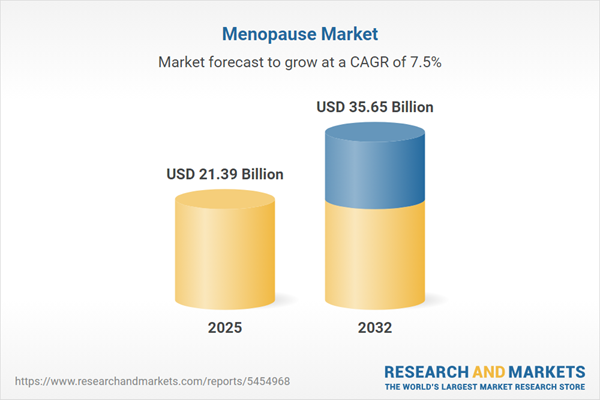Speak directly to the analyst to clarify any post sales queries you may have.
The menopause market is undergoing rapid transformation, with shifting patient needs and emerging therapies redefining standards in women's health. Senior decision-makers navigating this landscape require in-depth insights to align innovation, supply chain resilience, and commercial strategies effectively.
Menopause Market Snapshot
The menopause market grew from USD 19.97 billion in 2024 to USD 21.39 billion in 2025 and is projected to continue expanding at a CAGR of 7.51%, reaching USD 35.65 billion by 2032. Market growth is driven by increased focus on women's health, rising global awareness, and continued investment in personalized care models. Stakeholders operating in this space are directly impacted by evolving patient expectations, ongoing regulatory updates, and new treatment modalities poised to change the patient journey.
Scope & Segmentation
- Product Types: Hormone Replacement Therapy (HRT), Combined Estrogen-Progesterone Therapy, Estrogen Therapy, Progesterone Therapy, Non-Hormonal Treatments, Antidepressants (Citalopram, Escitalopram, Fluoxetine), Botanical Supplements, Gabapentin, Pregabalin.
- Stage of Menopause: Menopause, Perimenopause, Postmenopause.
- Route of Administration: Enteral, Parenteral, Topical.
- Distribution Channels: Hospital Pharmacies, Online Pharmacies, Company Websites, eCommerce Platforms, Retail Pharmacies.
- Geographies Covered: Americas (United States, Canada, Mexico, Brazil, Argentina, Chile, Colombia, Peru), Europe (United Kingdom, Germany, France, Russia, Italy, Spain, Netherlands, Sweden, Poland, Switzerland), Middle East (United Arab Emirates, Saudi Arabia, Qatar, Turkey, Israel), Africa (South Africa, Nigeria, Egypt, Kenya), Asia-Pacific (China, India, Japan, Australia, South Korea, Indonesia, Thailand, Malaysia, Singapore, Taiwan).
- Key Industry Players: Abbott Laboratories, Abbvie Inc., Amgen Inc., Apotex Inc., Astellas Pharma Inc., AstraZeneca PLC, Bayer AG, Cipla Ltd., Eli Lilly and Company, Ferring International Center S.A., Fervent Pharmaceuticals, Gedeon Richter PLC, GlaxoSmithKline PLC, Glenmark Pharmaceuticals Ltd., Ipsen Group, Merck & Co.Inc., Mithra Pharmaceuticals S.A., Novartis AG, Novo Nordisk A/S, Organon & Co, Pfizer Inc., Sun Pharmaceutical Industries Ltd., Teva Pharmaceutical Industries Ltd., TherapeuticsMD Inc., Viatris Inc.
Key Takeaways for Senior Decision-Makers
- Innovation in therapies is accelerating, with both hormonal and non-hormonal solutions expanding the scope of symptom management. Companies are increasingly targeting both clinical efficacy and improved patient adherence.
- Digital health technologies and telemedicine are now integral to patient engagement, offering tailored educational resources and enabling convenient monitoring across multiple platforms.
- Regionally, market dynamics vary significantly with localized regulatory requirements, access challenges, and differing reimbursement structures influencing adoption of menopause care solutions.
- Strategic collaborations, including partnerships between pharmaceutical manufacturers, biotech firms, and eCommerce platforms, provide competitive differentiation and greater market reach through innovative distribution strategies.
- Data-driven product development and adaptive clinical trial designs, supported by integration of real-world evidence, are instrumental for faster approvals and payer confidence.
Tariff Impact
The 2025 United States tariffs have reshaped sourcing and procurement strategies in the menopause treatment landscape. Higher import duties on active pharmaceutical ingredients have prompted manufacturers to reassess supplier contracts and explore domestic production. These changes affect downstream partners, requiring scenario planning and investment in advanced forecasting tools to maintain supply chain resilience and stable cost structures.
Methodology & Data Sources
This report utilizes a comprehensive methodology incorporating primary interviews with endocrinologists, regulatory experts, and industry leaders, as well as surveys targeting healthcare providers and distributors. Secondary data from clinical trials, industry reports, regulatory filings, and peer-reviewed journals reinforces findings and ensures cross-validated insights for market analysis.
Why This Report Matters
- Delivers actionable guidance for portfolio alignment with dynamic patient needs and regulatory landscapes in the menopause market.
- Enables identification of high-value growth opportunities by mapping evolving segmentation, regional trends, and competitive strategies.
- Supports supply chain stability through risk assessment, scenario planning, and adaptive sourcing recommendations in the face of tariff shifts.
Conclusion
This research gives business leaders clarity to navigate a rapidly evolving menopause market shaped by innovation, regulatory change, and patient empowerment. Strategic adoption of insights from this report empowers effective decision-making for sustained growth and patient-centered outcomes.
Additional Product Information:
- Purchase of this report includes 1 year online access with quarterly updates.
- This report can be updated on request. Please contact our Customer Experience team using the Ask a Question widget on our website.
Table of Contents
3. Executive Summary
4. Market Overview
7. Cumulative Impact of Artificial Intelligence 2025
List of Figures
Samples

LOADING...
Companies Mentioned
The key companies profiled in this Menopause market report include:- Abbott Laboratories
- Abbvie Inc.
- Amgen Inc.
- Apotex Inc.
- Astellas Pharma Inc.
- AstraZeneca PLC
- Bayer AG
- Cipla Ltd.
- Eli Lilly and Company
- Ferring International Center S.A.
- Fervent Pharmaceuticals, LLC
- Gedeon Richter PLC
- GlaxoSmithKline PLC
- Glenmark Pharmaceuticals Ltd.
- Ipsen Group
- Merck & Co.Inc.
- Mithra Pharmaceuticals S.A.
- Novartis AG
- Novo Nordisk A/S
- Organon & Co
- Pfizer Inc.
- Sun Pharmaceutical Industries Ltd.
- Teva Pharmaceutical Industries Ltd.
- TherapeuticsMD Inc.
- Viatris Inc.
Table Information
| Report Attribute | Details |
|---|---|
| No. of Pages | 189 |
| Published | October 2025 |
| Forecast Period | 2025 - 2032 |
| Estimated Market Value ( USD | $ 21.39 Billion |
| Forecasted Market Value ( USD | $ 35.65 Billion |
| Compound Annual Growth Rate | 7.5% |
| Regions Covered | Global |
| No. of Companies Mentioned | 26 |









